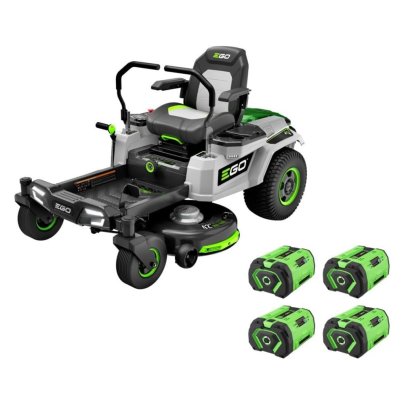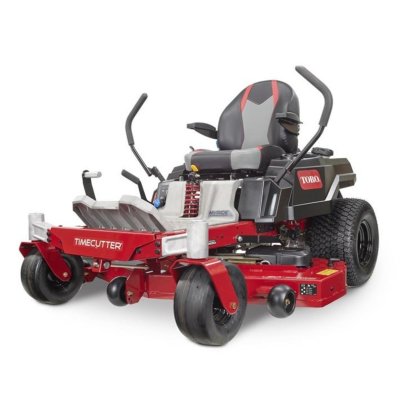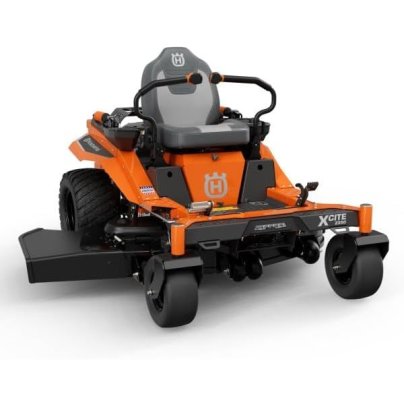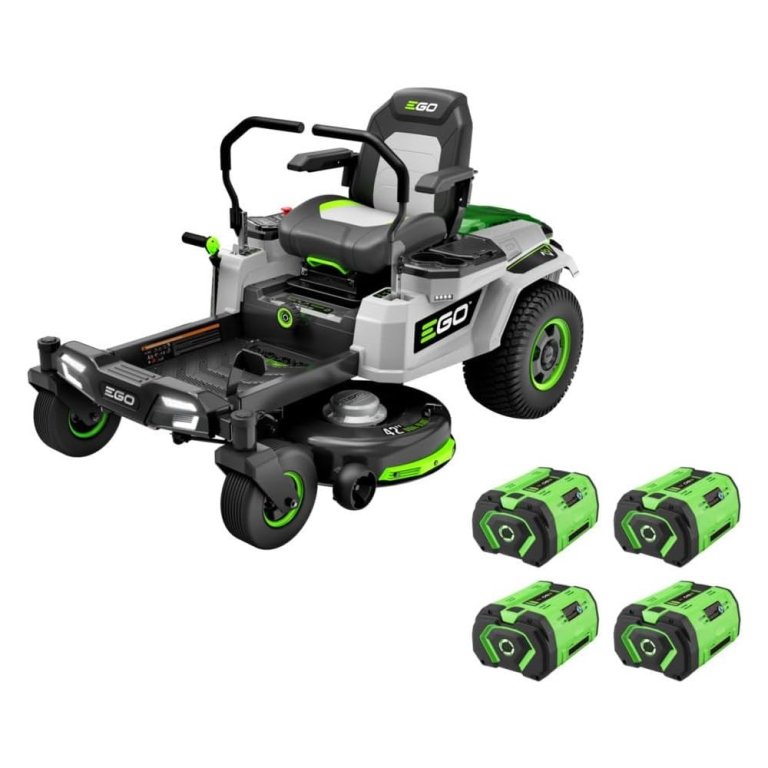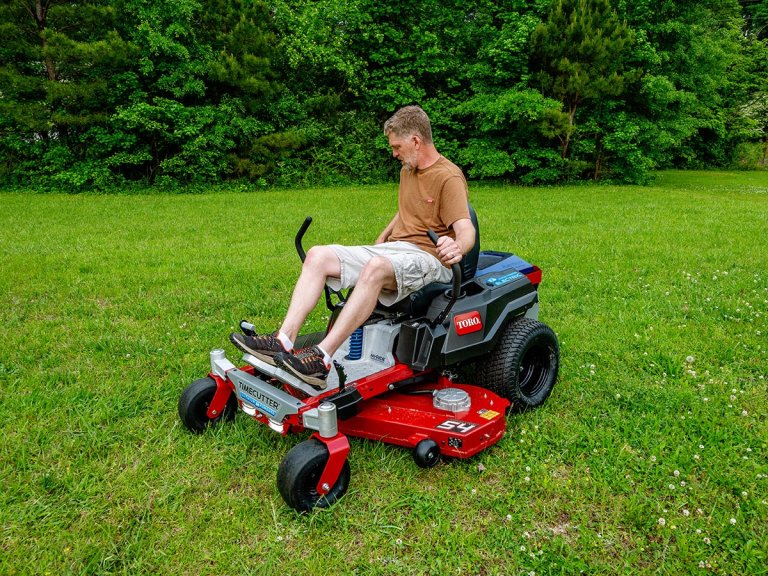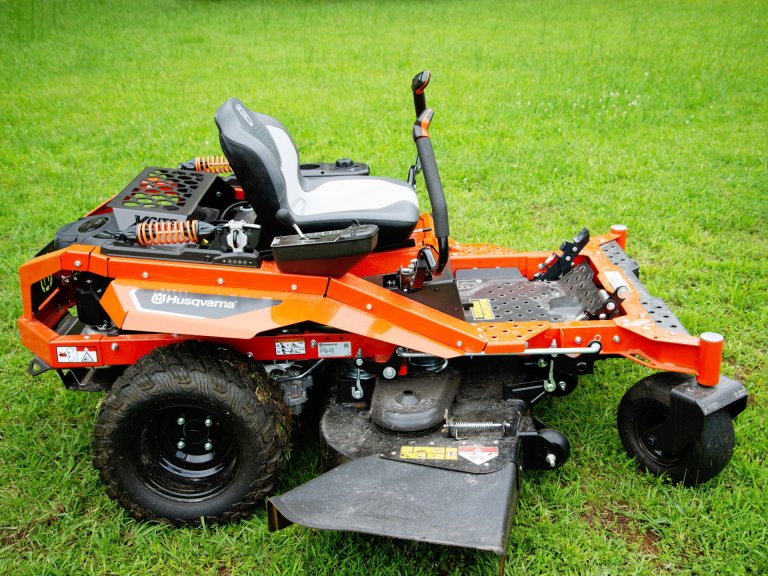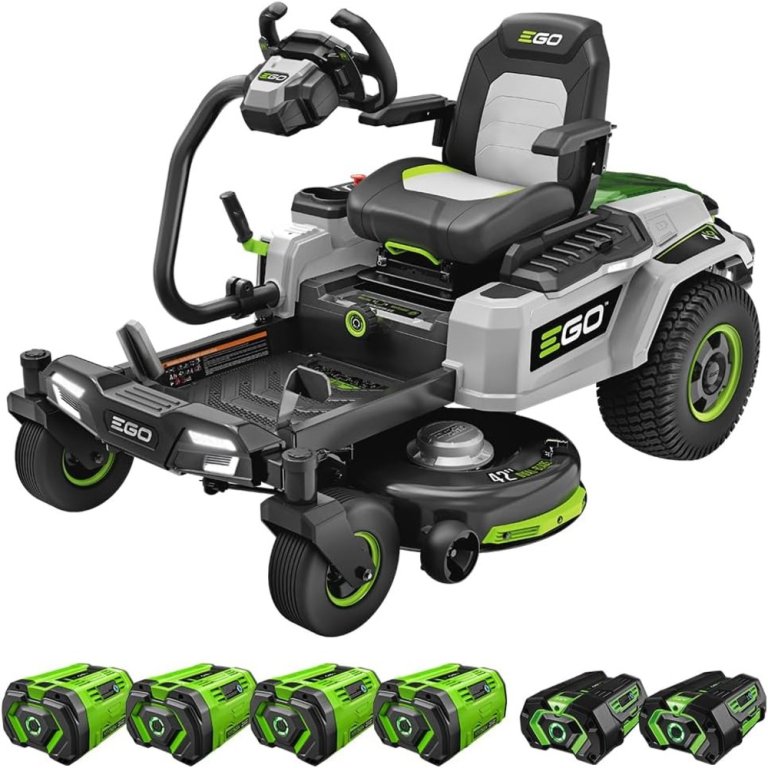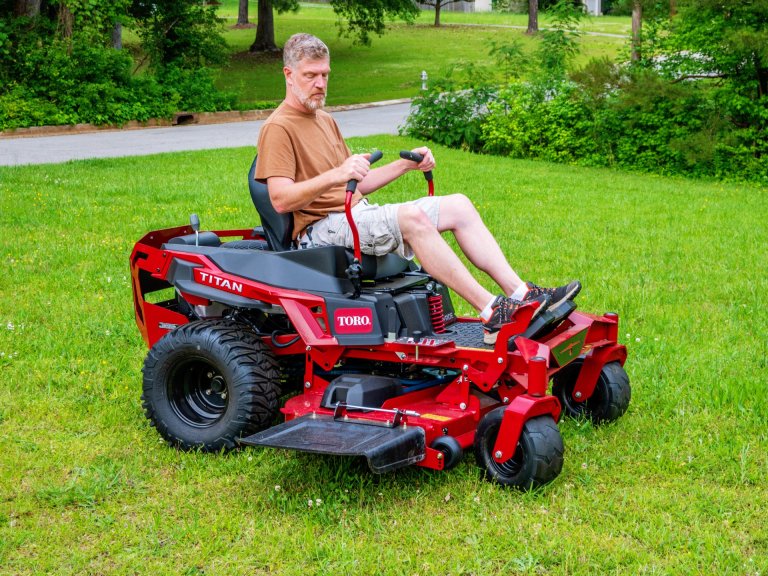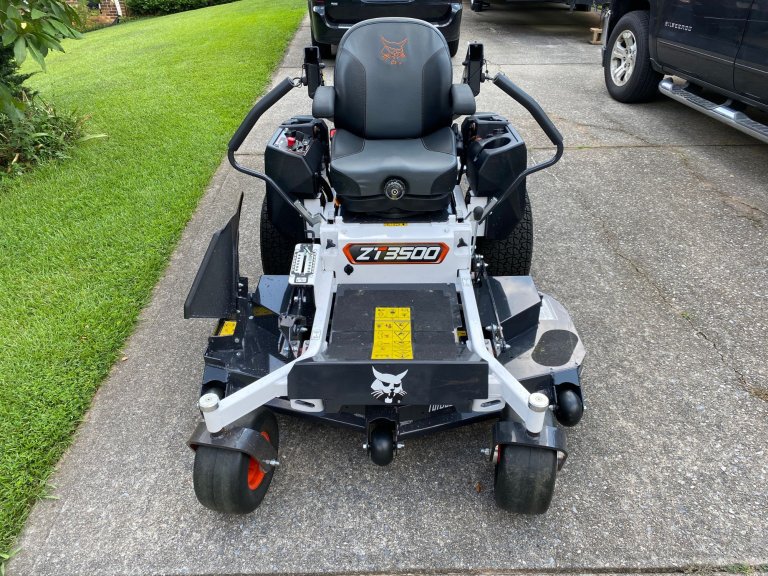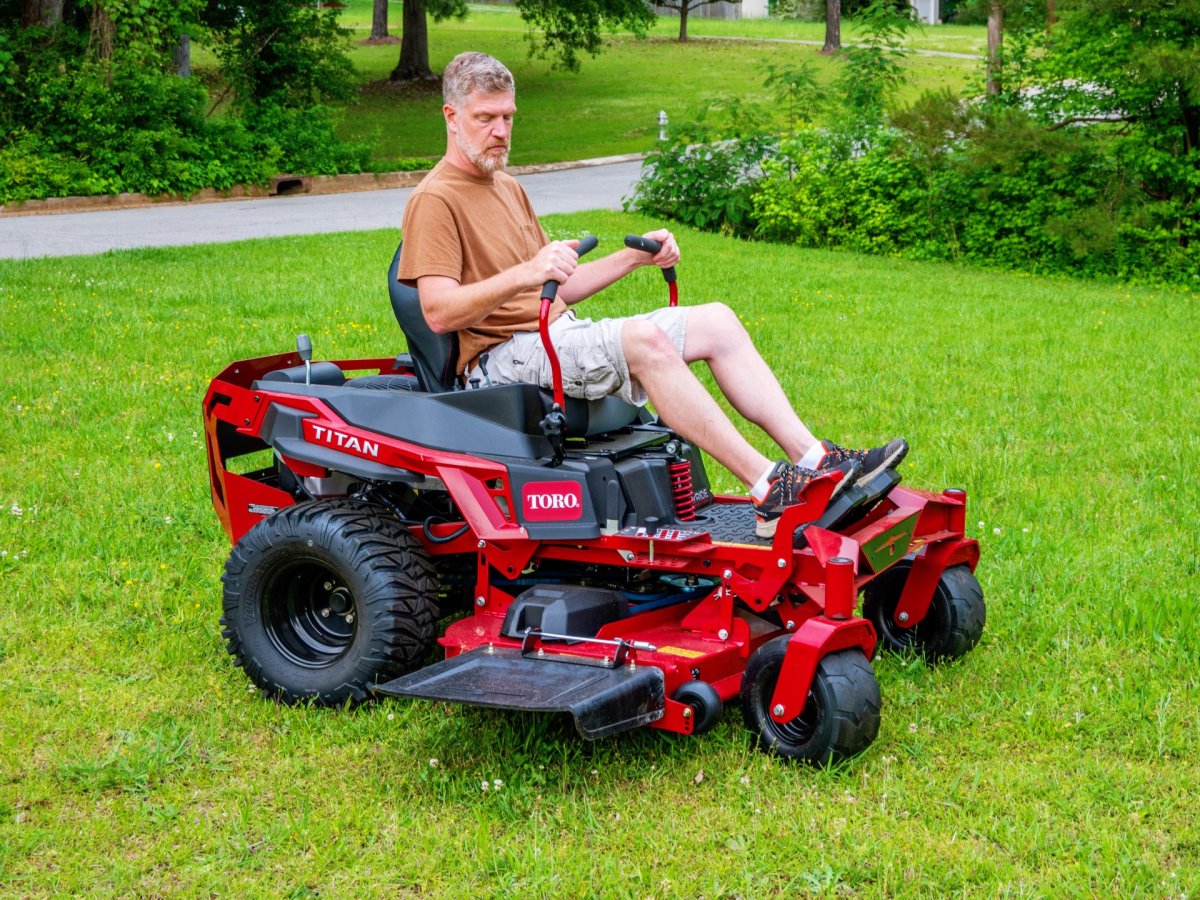
We may earn revenue from the products available on this page and participate in affiliate programs. Learn More ›
As indicated by their name, zero-turn mowers are designed to turn on a zero-degree radius for easy maneuvering. By pivoting within their own footprint, essentially spinning in place, they ensure you don’t miss patches of grass, making lawn care more efficient. In addition to greatly reducing mowing time, these mowers also deliver a cleaner, more professional-looking finish, making them a smart investment for those with properties of at least ⅓ acre seeking excellent performance and quality results.
Since zero-turn mowers are typically large and somewhat expensive, choosing the right option for your property can be challenging. To help narrow down your choices, we researched the most popular zero-turn mowers on the market and tested seven firsthand before selecting the Ego Power+ ZT4204L 42″ Z6 56V Zero-Turn Riding Mower as the best overall electric model and the Toro 50″ TimeCutter MyRide Zero-Turn Mower as the best overall gas model. Both machines offer excellent speed and performance, a comfortable ride, and top-of-the-line maneuverability.
The ideal zero-turn mower for you will depend on your yard’s size, incline, and landscaping. Below you’ll find our top picks for the best zero-turn mowers based on hands-on testing, along with a detailed guide to help you choose the right model for your needs.
- BEST OVERALL ELECTRIC: Ego Power+ ZT4204L 42″ Z6 56V Zero-Turn Riding Mower
↓ Jump to Review - BEST OVERALL GAS: Toro 50″ TimeCutter MyRide Zero-Turn Mower
↓ Jump to Review - BEST BANG FOR THE BUCK: Husqvarna Xcite Z350 Zero-Turn Riding Lawn Mower
↓ Jump to Review - BEST LOW-MAINTENANCE: John Deere Z370R Electric ZTrak Riding Mower
↓ Jump to Review - BEST STEERING SYSTEM: Ego Power+ ZT4205S 42″ Z6 Zero-Turn Mower With E-Steer
↓ Jump to Review - BEST FOR LARGE ACREAGES: Toro 60″ Titan MyRide Zero-Turn Mower
↓ Jump to Review - BEST FOR RUGGED TERRAIN: Bobcat ZT3500 Zero-Turn Riding Mower
↓ Jump to Review
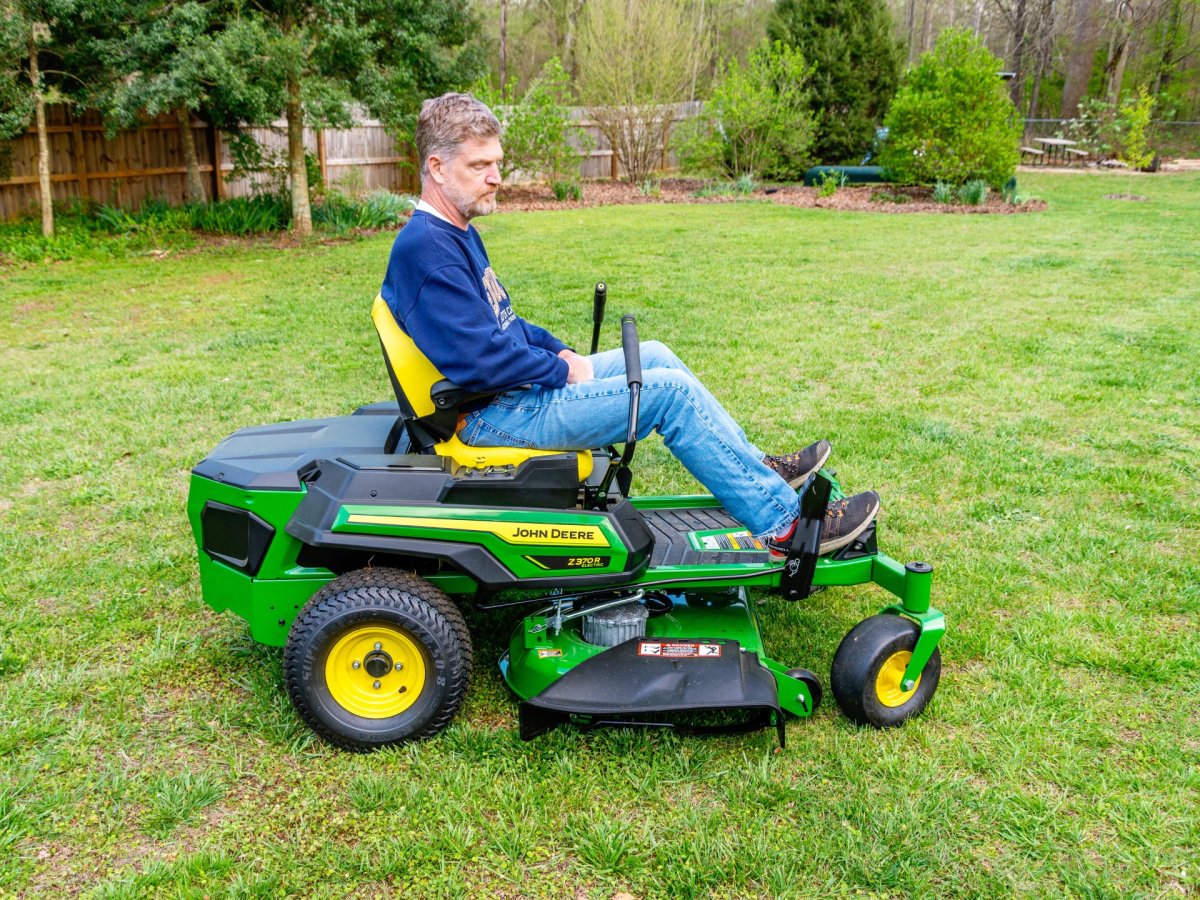
Zero-Turn Mowers Comparison
| Product | Power Source | Deck Size | Maximum Forward Speed |
|---|---|---|---|
| Ego Power+ ZT4204L 42″ Z6 56V Zero-Turn Riding Mower | Four 56V lithium batteries | 42 inches | 7 mph |
| Toro 50″ TimeCutter MyRide Zero-Turn Mower | Toro 24.5 hp gas engine | 50 inches | 7 mph |
| Husqvarna Xcite Z350 Zero-Turn Riding Lawn Mower | Kohler 24 hp gas engine | 54 inches | 8 mph |
| John Deere Z370R Electric ZTrak Riding Mower | One 58V lithium battery | 42 inches | 7 mph |
| Ego Power+ ZT4205S 42″ Z6 Zero-Turn Mower With E-Steer | Four 56V lithium batteries | 42 inches | 8 mph |
| Toro 60″ Titan MyRide Zero-Turn Mower | Kohler 26 hp gas engine | 60 inches | 8.5 mph |
| Bobcat ZT3500 Zero-Turn Riding Mower | Kawasaki 22 hp gas engine | 52 inches | 10 mph |
Before You Buy a Zero-Turn Mower
Most zero-turn mowers have a cutting radius of between 42 and 60 inches, meaning even relatively small zero-turn mowers make fast work of trimming large yards—especially those with thick grass that’s tedious to cut using a push mower. Thanks to their exceptional maneuverability, these mowers are also great for properties with organic landscaping designs and irregular shapes. However, if your yard is a simpler rectangular plot, a standard riding mower might do the job just fine.
Before investing in a zero-turn mower, it’s worth asking whether such a heavy-duty machine is overkill. For small to medium-sized lawns—especially those under a half-acre—a quality push mower may be more practical and cost-effective.
Equally important when choosing a mower is which power source will work best for mowing your lawn. Gas-powered engines are common, but they produce emissions and contribute to noise pollution, causing them to be increasingly restricted in various communities. Fortunately, electric zero-turn mowers are becoming more widely available, offering quieter, cleaner operation and comparable performance.
Our Top Picks
Don’t make a lawn mowing mistake by choosing a zero-turn model that isn’t right for your needs. The following mowers excelled during testing, making each one an excellent pick in terms of speed, performance, comfort, and value.
Best Overall Electric
Photo: AmazonWhat We Like
- 42-inch deck with 10 height settings
- Can add 2 additional batteries to increase runtime
- Onboard rapid battery-charging system
- Emission-free operation as powerful as 22 horsepower (hp) engine
What We Don’t Like
- Struggles slightly in overgrown areas
- Lap bars and casters feel loose in tight spaces
Product Specs
- Power source: Four 56-volt (V) lithium batteries
- Deck size: 42 inches
- Maximum forward speed: 7 miles per hour (mph)
Our Ratings: Mowing Speed 4.5/5; Cut Quality 4/5; Maneuverability 4.5/5; Operator Comfort 4.5/5; Value 4.5/5
Thanks to the Ego Power+ ZT4204L electric zero-turn lawn mower, those with big yards and bigger mowing expectations can finally ditch the gas can. Powered by four 56V 10-Ah lithium-ion batteries (with the option to add two more), it mows up to 2 acres per charge (or nearly 3 with a full battery bay) and offers features typically reserved for gas-powered machines, including adjustable lap bars, a 42-inch deck with 10 height settings, a high-back suspension seat, and side-discharge, mulch, or bagging options. Its electric output is equivalent to that of a 22 hp gasoline engine.
This Ego zero-turn riding mower independently drives the wheels and blades with adjustable power to conserve battery life when mowing easier areas or to amp up when tackling tougher patches. We spent about a month testing it on 2.25 acres of rolling terrain and were impressed with its incredibly quiet operation, smooth startup, and intuitive controls, gauges, and adjustments. It also has bright LED headlights, a battery-life indicator, and the fastest rapid-charge adapter in the industry, topping off a set of depleted batteries in just 2 hours.
As much as we enjoyed using this mower, it did have a few drawbacks. The lap bars and front casters felt loose when navigating in tight spaces, and the relatively small rear tires and overall lightweight made the ride a bit bouncy on rough ground. Also, while this model did a great job in “standard” mode (medium blade speed) while cutting well-maintained areas, it struggled slightly in overgrown crabgrass. Still, for those with large properties seeking a quieter, cleaner alternative to gas, this mower is an excellent choice.
What our tester says: “This was the very first battery-powered zero-turn model I tested. It ran much longer and moved much faster than I expected, but I do wish the maneuverability was a bit tighter. In terms of value, it’s definitely a rock-solid option.”—Mark Wolfe, Product Reviews tester and writer
Get the Ego ZT4204L zero-turn mower at Amazon or Ace Hardware.
Best Overall Gas
Toro 50" TimeCutter MyRide Zero-Turn Mower
Buy at SoharsWhat We Like
- Incredibly smooth ride, even on bumpy ground
- Holds enough gas to mow up to 4 acres
- Durable 50-inch, 10-gauge steel deck
- Intuitive dual-level steering controls
What We Don’t Like
- Not rated for steep slopes
- Too wide for walk-through gates
Product Specs
- Power source: Toro 24.5 hp gas engine
- Deck size: 50 inches
- Maximum forward speed: 7 mph
Our Ratings: Mowing Speed 4.5/5; Cut Quality 4.5/5; Maneuverability 4.5/5; Operator Comfort 5/5; Value 4.5/5
The Toro 50-inch TimeCutter zero-turn gas mower earned its place on our list for its speed, comfort, maneuverability, and professional-quality finish. Powered by a 24.5 hp Toro commercial V-Twin engine, it mows at up to 7 miles per hour, using a 10-gauge steel deck with triple blades to ensure a clean, precise cut. It features dual hydrostatic HG-ZT 2200 transaxles for smooth, responsive operation, whether you’re mowing open fields or maneuvering around landscaping.
This was one of the most reliable zero-turn mower models we tested, starting consistently and shifting between mowing, towing, and trimming tasks easily. It cut a 2-acre property in about 40 minutes on a single 3-gallon tank of gas. Maintenance was surprisingly simple thanks to its built-in deck washout port and toolless oil change system. But what we liked best was its comfort. The MyRide suspension system allowed more than 3 inches of travel between the seat and frame, helping absorb bumps on rough terrain. Combined with the 18-inch hand-sewn high-back seat, padded foldaway armrests, and foot-operated deck height adjustment, we found mowing large areas much less fatiguing.
The downsides of this Toro are minimal and relatively common to most zero-turn mowers. Its 50-inch deck is too wide for tight spots, and Toro recommends avoiding slopes steeper than 15 degrees. For those with relatively flat and accessible properties, the TimeCutter delivers outstanding performance, comfort, and durability.
What our tester says: “After testing this Toro for more than a month, we came to appreciate a whole host of its features. The combination of pro-quality construction and performance, combined with perhaps the most comfortable ride in the industry, makes it pretty hard to beat.”—Mark Wolfe, Product Reviews tester and writer
Read our full review: Toro 50-Inch TimeCutter MyRide Zero-Turn Mower
Get the Toro TimeCutter at Sohars.
Best Bang Fot The Buck
Husqvarna Xcite Z350 Zero-Turn Riding Lawn Mower
Buy at AmazonWhat We Like
- Excellent cut quality at high speed
- Powerful 24 hp engine and 54-inch fabricated 10-gauge steel deck
- Intuitive hand grip controls and digital dashboard
What We Don’t Like
- Not designed for steep slopes
Product Specs
- Power source: Kohler 24 hp gas engine
- Deck size: 54 inches
- Maximum forward speed: 8 mph
Our Ratings: Mowing Speed 4.5/5; Cut Quality 4.5/5; Maneuverability 4/5; Operator Comfort 4.5/5; Value 4.5/5
If you’re looking at cheap zero-turn mowers but don’t want to sacrifice speed, comfort, and precision, the Husqvarna Xcite Z350 zero-turn riding lawn mower is an excellent option. It’s powered by a 24 hp Kohler engine and has a 54-inch 10-gauge steel deck, delivering professional-grade performance at a reasonable price. It also features a customizable SmoothRide suspension system that absorbs bumps to reduce operator fatigue on uneven terrain.
During testing, we adjusted the suspension and were immediately impressed by the ride quality and seat comfort—though we recommend opting for the add-on armrests. We also appreciated that the push-button electronic start/stop and PTO (power takeoff) controls were located on the hand grips and that the digital dashboard showed fuel levels and service alerts.
In terms of performance, it cut an overgrown 1-acre field in just over 20 minutes and handled a more intricate residential lawn just as well. While the 54-inch deck is too wide to pass through narrow gates and isn’t designed for use on steep slopes, this mower’s fast-spinning DuraSharp blades and deep cutting deck deliver a clean, even finish. For those with large, relatively flat properties, it offers excellent comfort and results without an especially high price tag.
Read our full review: Husqvarna Xcite Z350 Zero-Turn Riding Lawn Mower
Get the Husqvarna zero-turn mower at Amazon.
Best Low Maintenance
John Deere Z370R Electric ZTrak Riding Mower
Buy at John DeereWhat We Like
- Mows up to 2 acres per charge
- Safe to wash with a hose; sealed battery has an IP66 rating
- Easy, intuitive controls and LCD status screen
- Comfortable, high-back seat with armrests
What We Don’t Like
- Takes about 6 hours to fully recharge
- Struggles to track along curved edges
Product Specs
- Power source: One 58V lithium battery
- Deck size: 42 inches
- Maximum forward speed: 7 mph
Our Ratings: Mowing Speed 4/5; Cut Quality 4/5; Maneuverability 4/5; Operator Comfort 4.5/5; Value 4/5
The John Deere Z370R Ztrak electric riding mower brings modern battery technology to the brand’s time-tested mowing platform. As John Deere’s first all-electric residential zero-turn mower, the Z370R blends classic mowing performance with quiet, low-maintenance operation. After testing it on a 1.5-acre residential lot, we came away impressed by its capability, comfort, and user-friendly features.
Powered by a 58-volt lithium-ion battery, the Z370R can mow up to 2 acres per charge under average conditions. It uses a 42-inch Accel Deep deck to deliver a clean cut across various grass types, including thicker, weedy areas and taller growth. The airflow through the deck disperses clippings efficiently, leaving behind an even finish with minimal clumping—even at full mowing speed. It also has a contoured high-back seat with armrests, intuitive controls, a USB port, onboard storage, and a visible battery indicator.
Though this battery-powered zero-turn mower takes about 6 hours to fully charge, the process is simple thanks to a built-in smart charger that connects to any standard 120V outlet. Smart power management kicks in when the battery is low, ensuring you have enough life to get back to an outlet. Our only real complaint is that the deck doesn’t extend much beyond the rear wheels, making edging along curved beds a bit of a challenge. Still, even though that means a bit more work with a string trimmer, we think the lack of fuel, oil changes, and engine maintenance tips the scales.
Read our full review: John Deere Z370R Electric ZTrak Riding Mower
Get the John Deere zero-turn mower at John Deere.
Best Steering System
Ego Power+ ZT4205S 42" Z6 Zero-Turn Mower With E-Steer
Buy at Amazon Buy at Acme Tools Buy at SoharsWhat We Like
- e-STEER technology is intuitive to operate
- Expandable battery system is great for large properties
- Adjustable hydraulic seat, LED headlights, USB port, and Bluetooth
What We Don’t Like
- LCD display sometimes has glare issues
Product Specs
- Power source: Four 56V lithium batteries
- Deck size: 42 inches
- Maximum forward speed: 8 mph
Our Ratings: Mowing Speed 4.5/5; Cut Quality 4.5/5; Maneuverability 5/5; Operator Comfort 5/5; Value 4/5
Zero-turn mowers with steering wheels aren’t especially common, meaning the e-STEER technology of the Ego ZT4205S is relatively unique. This is one of our favorite upgrades on this unit. It combines the agility of a zero-turn mower with the intuitive control of a steering wheel to make it easier to transition from a traditional machine.
The ability to steer with a traditional steering wheel made maneuvering around structures, like a pool on our test lawn, easy and effortless. It also comes with four 56V 12 Ah lithium batteries (equivalent to a 22 hp gas engine), allowing you to mow up to 2.5 acres on a single charge. In testing, we were able to mow an entire 2-acre property and a neighboring property on a single charge.
The ZT4205S offers three driving modes for various terrain—control, standard, and support—which are easy to access via an LCD interface, though it can sometimes be hard to read in direct light due to glare. It has a 42-inch cutting deck with 10 height positions between 1.5 and 4.5 inches and supports mulching, bagging, and side-discharge functions. This eclectic zero-turn mower also features adjustable hydraulic seat suspension, 32 on-body LED lights, IPX4 weather-resistant construction, Bluetooth connectivity, a USB charging port, and a phone holder.
For those looking to transition from a stand-up zero-turn mower or upgrade from a standard riding lawn mower with a bagger, this pick offers an exceptional combination of power, comfort, and user-friendliness. It’s an especially good choice for homeowners who want gas-like performance with the quiet and clean operation of batteries.
What our tester says: “The Ego Z6 makes quick work of our 2+ acres. The padded seat, easy steering, and bonus cup and phone holders make cutting our property fun and enjoyable.”—Stephanie Cronk, Product Reviews tester and writer
Get the Ego ZT4205S zero-turn mower at Amazon, Acme Tools, or Sohars.
Best for Large Acreages
Photo: Debbie Wolfe for Bob VilaWhat We Like
- Powerful 26 hp engine cuts up to 4.6 acres per hour
- MyRide suspension system absorbs bumps
- Durable 60-inch, 10-gauge fabricated deck
What We Don’t Like
- Loud at full throttle
Product Specs
- Power source: Kohler 26 hp gas engine
- Deck size: 60 inches
- Maximum forward speed: 8.5 mph
Our Ratings: Mowing Speed 4.5/5; Cut Quality 5/5; Maneuverability 4.5/5; Operator Comfort 5/5; Value 4.5/5
Homeowners tackling 3 acres or more need a mower with a wide deck and a powerful motor—two things that come standard on the Toro Titan zero-turn mower. Its 26 hp commercial-grade Kohler engine and 60-inch fabricated steel deck are built to handle big jobs fast, mowing up to 4.6 acres per hour under ideal conditions.
Combined with oversize 22-inch drive wheels and the brand’s MyRide suspension system, it’s as comfortable as it is quick, even at its top speed of 8.5 mph. During testing, we consistently mowed just over an acre in under 30 minutes, including rough patches and light inclines, without compromising cut quality or comfort.
Toro’s attention to comfort and durability makes this model feel like a commercial mower in a residential package. The high-back seat, intuitive controls, foot-operated deck lift, and elevated view add to the premium feel. Blade tip speed and deck airflow work well together, producing a clean, consistent cut without leaving behind unsightly clumps.
Still, this mower isn’t for everyone. Its large size makes it impractical for tight areas, and, as is common with zero-turn mowers, you should avoid slopes beyond 15 degrees for safety. If you’re comparing zero-turn mowers for 5 acres and hoping for a model that’s fast, fuel-efficient, and comfortable, the Titan is ideal.
Read our full review: Toro 60″ Titan MyRide Zero-Turn Mower
Get the Toro Titan zero-turn mower at Tractor Supply Co. or Toro.
Best For Rugged Terrain
Bobcat ZT3500 Zero-Turn Riding Mower
Buy at BobcatWhat We Like
- Commercial-level cut quality
- Tracks straight and handles smoothly
- Comfortable, bump-absorbing ride
What We Don’t Like
- Comes at a premium price
Product Specs
- Power source: Kawasaki 22 hp gas engine
- Deck size: 52 inches
- Maximum forward speed: 10 mph
Our Ratings: Mowing Speed 5/5; Cut Quality 4.5/5; Maneuverability 4.5/5; Operator Comfort 4.5/5; Value 4/5
If you mow more than a couple of acres or mow for income, an inexpensive and moderately durable mower might not cut it long term. Though the Bobcat ZT3500 costs more upfront, it delivers where it counts: durability, comfort, and professional-grade performance. It features top-tier components like a 22 hp Kawasaki FX engine, Hydro-Gear ZT-3400 transaxles, a rugged 7-gauge steel frame, and a rollover protection system. It’s also fast and fuel-efficient, using just 3 gallons of gas to mow 6 acres in about an hour.
After spending 10 days testing the ZT3500, mowing a combination of mixed terrain, slopes, uneven patches, and narrow corridors, we were impressed with its smooth and powerful performance, even in thick, overgrown grass. Its deep 52-inch TufDeck Pro cutting deck produced a crisp cut across a 20-foot swath, even at its max speed of 10 mph, without clumping or forming windrows. The spring-suspension seat with armrests and large 23-inch rear tires made for a surprisingly smooth ride, and maneuvering around landscape features felt intuitive thanks to responsive steering and lap bars that track straight with minimal effort.
Yes, this Bobcat is a serious investment. But for large property owners or small-scale pros, it pays for itself in saved time and hassle. If you want a mower that’ll last 20 years and deliver consistent results every week, the ZT3500 is worth every penny.
Read our full review: Bobcat ZT3500 Zero-Turn Riding Mower
Get the Bobcat zero-turn mower at Bobcat.
Jump to Our Top Picks
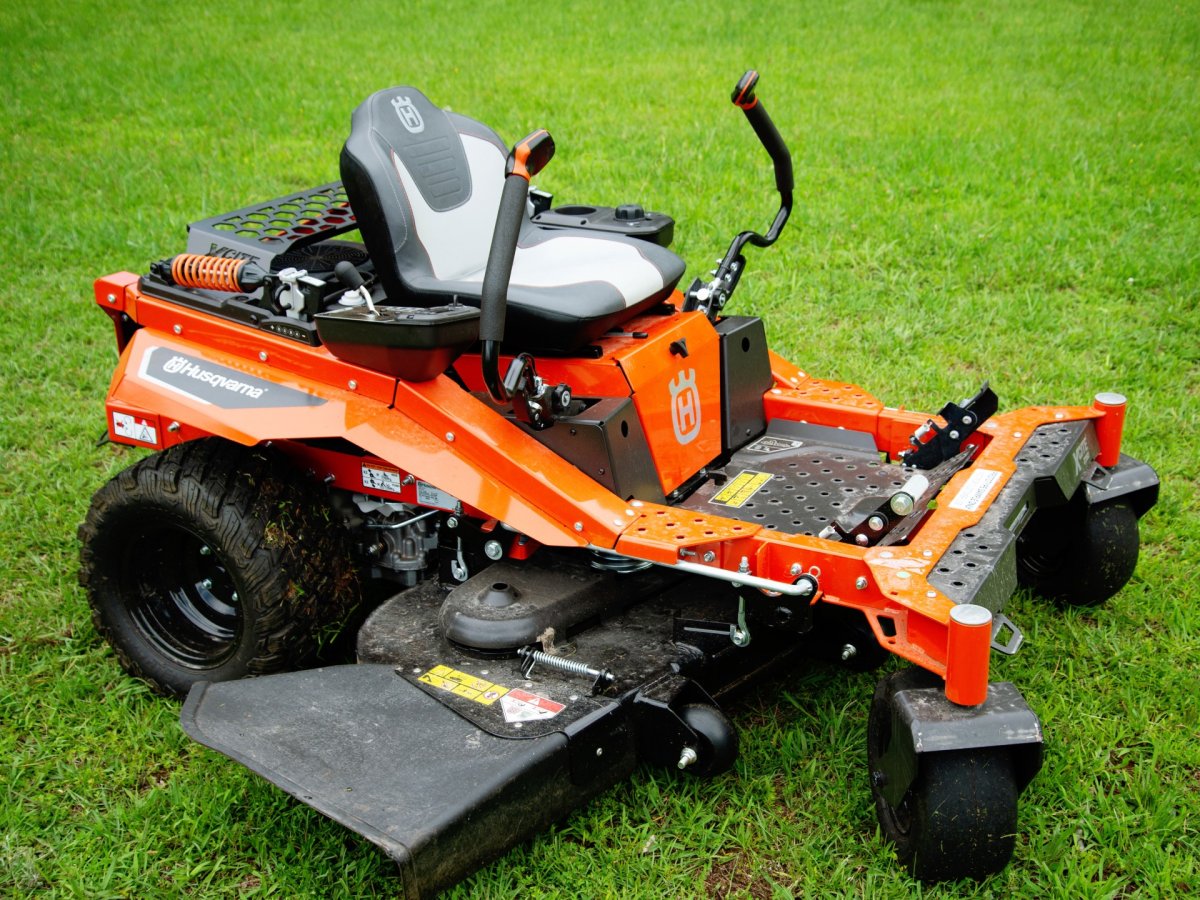
How We Tested the Best Zero-Turn Mowers
| Products tested | 7 |
| Time spent testing | Several months |
| Tests performed | 8 |
| Price range | $4,000 to $9,300 |
To create our list of the best zero-turn mowers, we started by considering more than 25 models from leading brands, focusing on key factors like deck size, max speed, comfort, cut quality, battery life or fuel efficiency, maneuverability, ease of maintenance, and value. We prioritized models offering a balance of value and durability at multiple price points to meet a range of budgets.
After narrowing down our top picks, we tested seven standout mowers on residential and rural properties over several months, cutting back overgrown areas, navigating uneven terrain, and edging along beds. If you’re looking to invest in a zero-turn mower, our testing and research will help you find the right fit.
| Product | Mowing Speed | Cut Quality | Maneuverability | Operator Comfort | Value |
| Ego Power+ ZT4204L 42″ Z6 56V Zero-Turn Riding Mower | 4.5 | 4 | 4.5 | 4.5 | 4.5 |
| Toro 50″ TimeCutter MyRide Zero-Turn Mower | 4.5 | 4.5 | 4.5 | 5 | 4.5 |
| Husqvarna Xcite Z350 Zero-Turn Riding Lawn Mower | 4.5 | 4.5 | 4 | 4.5 | 4.5 |
| John Deere Z370R Electric ZTrak Riding Mower | 4 | 4 | 4 | 4.5 | 4 |
| Ego Power+ ZT4205S 42″ Z6 Zero-Turn Mower With E-Steer | 4.5 | 4.5 | 5 | 5 | 4 |
| Toro 60″ Titan MyRide Zero-Turn Mower | 4.5 | 5 | 4.5 | 5 | 4.5 |
| Bobcat ZT3500 Zero-Turn Riding Mower | 5 | 4.5 | 4.5 | 4.5 | 4 |
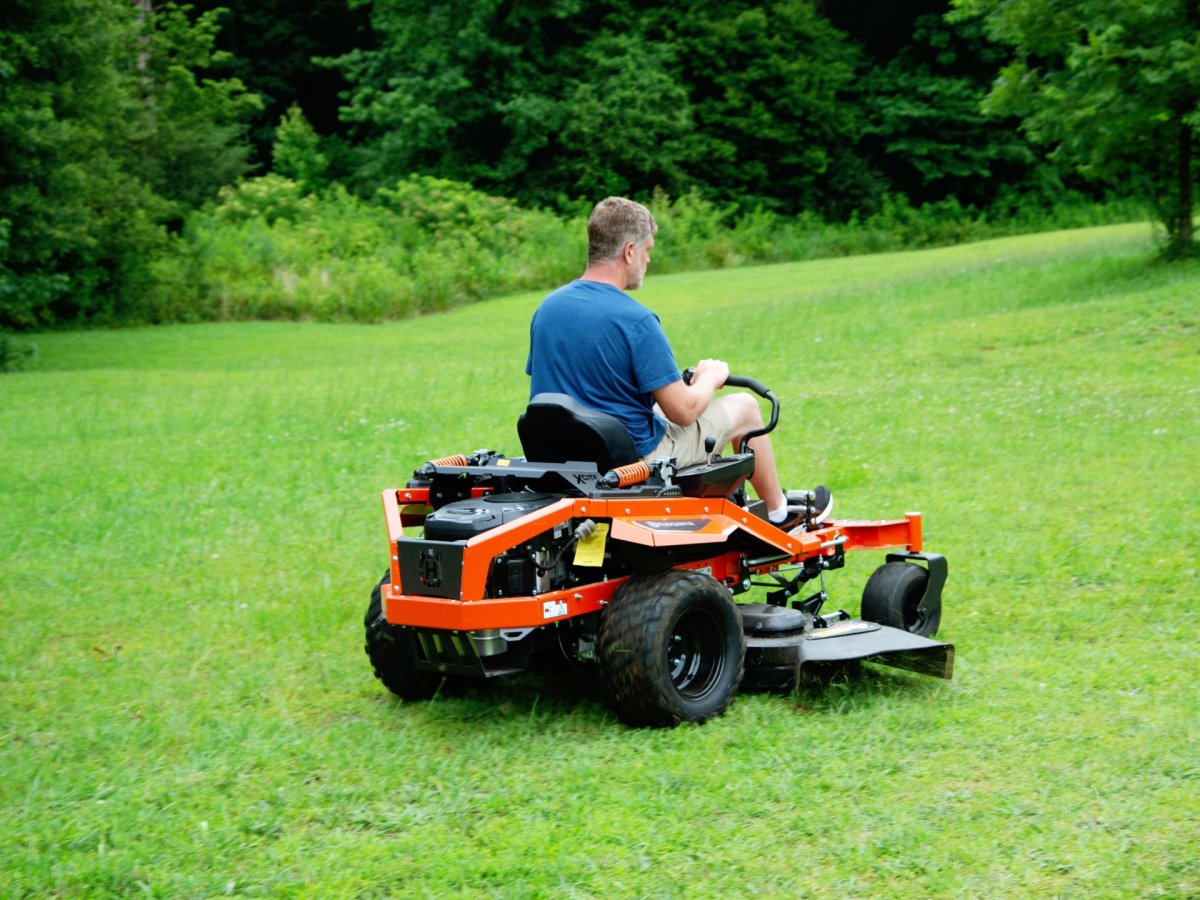
What to Consider When Choosing the Best Zero-Turn Mower
Before making a purchase, consider the following features to find the best lawn mower for your needs.
Types of Zero-Turn Mowers
Zero-turn mowers can be split into two broad categories based on power, size, and utility: residential and commercial.
Residential
Residential zero-turn mowers are smaller and less powerful than commercial zero-turn mowers. They can either be gas-powered or electric-powered, though gas-powered zero-turn mowers are still more popular since battery power is just now becoming substantial enough to support such massive machines.
This type of lawn mower is perfect for yards ranging from ⅓ to 4 acres; however, it may have difficulty navigating very rough terrain and steep inclines. Not surprisingly, residential zero-turn mowers are also less expensive, more fuel (or battery) efficient, and easier to learn to control than commercial models.
Commercial
If you need to tackle a very large area or have multiple large yards to mow regularly, then a commercial zero-turn mower makes sense. These mowers are much more powerful than residential zero-turn mowers, and they often have large cutting decks that can make your job much quicker.
However, all that power comes at a price. Commercial zero-turn mowers are more expensive than residential zero-turn mowers, and you will also end up paying more in fuel for a gas-powered model. In fact, due to the size and power required to operate a commercial zero-turn mower, this style is not typically available in electric or battery-powered options.
Yard Size and Ground Type
Unless you are swapping out your traditional lawn for a grass-free alternative, one of the first considerations to take into account when choosing a mower is the size and type of terrain you will be mowing.
- Residential zero-turn mowers are not suitable for rough terrain or mowing on an inclined slope that exceeds 15 degrees. These lightweight zero-turn mowers are also not designed for daily use and will wear out faster than commercial zero-turn mowers if they are used with the same frequency. This style of mower is intended for yards between ⅓ acre and 4 acres.
- Commercial zero-turn mowers are better able to maneuver on steep inclines and over rough terrain, though for very rough ground, consider a lawn tractor instead. Commercial zero-turn mowers are also more powerful and durable, intended for repeated daily use. They are best for yards that exceed 4 acres in size or for mowing multiple large yards regularly.
Gas vs. Electric
While gas-powered zero-turn mowers are more common, recent advances in battery technology have led to comparable electric-powered zero-turn mowers, which are excellent alternatives for smaller yards.
- Gas-powered zero-turn mowers have a wider price range because they are more common than the newer electric type. Gas-powered mowers tend to be more powerful than electric-powered mowers, but they also weigh more and require regular gas refills.
- Electric-powered zero-turn mowers are a relatively new innovation and are usually priced the same as mid-range gas-powered zero-turn mowers. Electric zero-turn mowers are not typically quite as powerful as commercial gas zero-turn mowers, but they do have comparable power outputs to mid-range residential gas riding lawn mowers—great news for most homeowners. In addition to operating without emissions, another major benefit of electric mowers is that you never need to pay for gas, though it does take time to recharge their batteries.
Horsepower
The power output of gas zero-turn lawn equipment is measured in horsepower (hp) and typically ranges from as low as 10 hp to over 25 hp.
- 10 to 20 hp zero-turn mowers are ideal for small yards with relatively flat terrain. This amount of horsepower is sufficient for 1 acre or less, but it isn’t the best option for multiple properties. Most residential mowers fall into this category.
- 20 to 25 hp zero-turn mowers are an excellent mid-range option that falls into the residential mower category. These mowers are equipped to handle larger yards of up to 3 acres, as long as the terrain isn’t too rough and inclines do not exceed 15 degrees.
- 25 hp and higher zero-turn mowers are most often from the commercial mower category. These powerful machines are designed for regular, repeated use on very large plots of land, like golf courses or multiple large yards.
Single-Cylinder vs. Twin-Cylinder Engines
Gas-powered zero-turn mowers can feature a single-cylinder engine or a twin-cylinder engine.
- Single-cylinder engines are less fuel-efficient, but they can be very loud because they are more susceptible to increased vibration. However, zero-turn mowers with single-cylinder engines are more affordable and may be all you need if you are only mowing once a week.
- Twin-cylinder engines are better for frequent mowing because they are more fuel-efficient and durable than single-cylinder engines. This type of zero-turn mower greatly reduces vibration, but it comes at a higher price.
Fuel Tank Capacity
Fuel tank capacity is an essential consideration for gas-powered zero-turn mowers. It won’t matter how fast or powerful the mower operates if you run out of fuel before you can finish the job. For plots of land that are 5 acres or more, choose a zero-turn mower with at least a 4-gallon tank.
If you will be using the zero-turn mower for 4 acres or less, then you can use a 3-gallon fuel tank. For smaller areas, a 2-gallon fuel tank will ensure you can mow the entire lawn without having to stop and refuel.
Battery Life and Runtime
Battery life and runtime are only applicable to electric zero-turn mowers, and even then, they are dependent on many other factors. For example, the age of the mower, how the mower is driven, the type of terrain on which it is used, the tire treads for ground grip strength, and the weight of the zero-turn mower can all impact how long a battery will last.
Battery power is often expressed in volts (V), typically ranging from 48V to 60V or more. Lower-voltage models around 48V are best suited for smaller yards—up to 2 acres—while higher-voltage systems like 60V or higher can handle 3 acres or more per charge. For larger properties or commercial use, having multiple battery packs or a fast-charging system can help extend mowing time without interruptions.
Cutting Deck
The cutting deck is the covered area on a zero-turn mower where the blades rotate to cut the lawn. The size of this deck can vary from a small, 32-inch cutting deck that is appropriate for yards less than 3 acres to a 61-inch cutting deck intended for golf courses or especially large yards.
While it may seem best to purchase the largest deck size within your budget to mow as quickly as possible, this could be counterproductive. Consider whether your yard has any obstacles that would be difficult to move around or between. If it does, then you would be better off with a smaller deck that’s easier to maneuver. Also, consider whether you’ll be bagging the grass or need a deck with mulching blades to help take care of it.
Seating
When it comes to operator comfort, look for zero-turn mowers with suspension and features that help reduce operator fatigue, including a generously padded seat cushion and a high backrest. Since you’ll be sitting on your machine for an extended period, you will likely also want cushioned armrests and an adjustable seat position.
Controls
Most zero-turn mowers have two levers that provide power to the drive wheels when you press them forward (away from the driver). One lever controls the drive wheel on the right side of the mower, while the other lever controls the drive wheel on the left side.
While there are no significant differences between the controls on zero-turn mower models, consider a product that comes with soft, ergonomic padding to help reduce hand fatigue during use. This padding will also help you grip the levers, even when your hands become sweaty while working in the hot sun. If you’re new to this type of mower, choosing a model with a steering wheel may make operation simpler, though these models are relatively rare.
Tires
The tires on just about any vehicle or wheeled machine are designed to help direct the movement of the object. Drive wheels on a zero-turn mower propel the mower forward but also help to grip the ground so you can turn effectively. All zero-turn mowers have similar air-filled tires to those you would find on a go-kart.
Consider the type of terrain you have and the amount of rainy weather in your area. If your zero-turn mower may need to operate on very wet grass or across rough terrain, then look for a product with very deep treads; this additional traction will ensure you can accelerate and turn without issue, even in poor conditions.
Safety
Zero-turn mowers are large machines that can be very dangerous. For this reason, many manufacturers add specific safety features, like parking brakes, headlights, and automatic shutdown.
- Parking brakes are a necessary safety feature for mowing sloping land. This simple addition to your zero-turn mower can protect you if you have to get off the mower for any reason while you are cutting.
- Headlights are definitely more of an added feature than a safety feature since you would normally mow the lawn during daylight hours. However, if you still have another 30 minutes of mowing to complete and the sun has set, headlights can help you finish the job while ensuring you can see properly.
- An automatic shutdown feature is designed to turn off the zero-turn mower when it senses that the driver of the mower is no longer in the seat. This safety feature means the mower will not continue operating should you leave it to move an obstacle or accidentally fall off.
FAQs
Before investing in one of the above best zero-turn mowers, take a look at these frequently asked questions to ensure you’ve completed every aspect of your research.
Zero-turn mowers are riding lawn mowers that can pivot within their own footprint, thanks to independent hydraulic control of each drive wheel. Instead of both wheels moving at the same speed, one stays still while the other moves, allowing the mower to spin in place for a zero-degree turning radius.
Both zero-turn mowers and lawn tractors have strengths and weaknesses. Zero-turn mowers are intended for medium to large yards with curves but not many inclines. They operate at a faster speed, but the controls may take some time to master. Lawn tractors have controls similar to a car, so they are relatively easy to learn, but they can’t make sharp turns. Both zero-turn mowers and lawn tractors risk tipping over if you use them on inclines greater than 15 degrees.
You steer a zero-turn mower using two control levers. Pushing both forward moves the mower straight ahead. To turn, you pull one lever back slightly, reducing power to that wheel while the other keeps moving. For a full zero-degree turn, pull one lever back all the way. This powers just one side of the mower while the other side stays still, causing the mower to spin in place.
Most zero-turn mowers don’t have a traditional foot-pedal brake, but they do have lever controls that increase or decrease the acceleration of the mower. They also typically come equipped with a parking brake or an emergency brake.
Zero-turn mowers can work on slight slopes, but they can tip over on inclines over 15 degrees.
To maintain a zero-turn mower, follow these steps:
1. If you have a gas model, regularly check and replace the oil, spark plugs, and air filter to ensure they all continue working effectively.
2. Clean the mower deck after each use to prevent dirt, grass, and other debris from building up. If you don’t regularly clean moisture from the deck caused by built-up grass clippings, it can cause significant damage to the deck and blades. Cleaning the mower deck also provides a much smoother cut.
3. Sharpen your lawn mower blades two to three times a year, depending on how frequently you mow.
4. Check the tires before every use to ensure they are all at the same air pressure and height.
5. Store your zero-turn mower in an enclosed space, like a shed or garage, so it isn’t exposed to rain, snow, or even extreme sunlight for an extended period.
Meet the Testers
Mark Wolfe is a writer and product tester with a background in the nursery and landscaping industry. For more than 20 years, he mowed, edged, planted, pruned, cultivated, irrigated, and renovated beautiful landscapes. Now he tests and writes reviews about the latest outdoor power equipment, hand tools, lawn care products, and other outdoor-living goods.
As the executive editor of Commerce/Product Reviews, Stephanie Cronk has spent years researching and testing products. She also brings over 12 years of commerce experience to the BobVila.com team, where her focus is on reviewing and testing products in a variety of categories, including DIY, home improvement, home appliances, outdoor living, and more.
Additional research provided by Timothy Dale.
